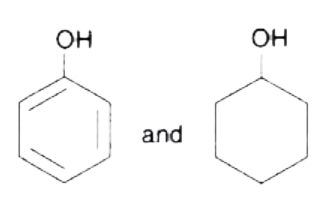Give a chemical test to distinguish between the following gases
NH3 and SO2
To distinguish between the gases ammonia (NH₃) and sulfur dioxide (SO₂), we can perform specific chemical tests. Here’s a step-by-step solution:
Step 1: Test with Litmus Paper
1. Take two pieces of moist litmus paper: One should be blue and the other should be red.
2. Expose the blue litmus paper to the gas: If the gas is ammonia (NH₃), the blue litmus paper will remain blue. If the gas is sulfur dioxide (SO₂), the blue litmus paper will turn red.
3. Expose the red litmus paper to the gas: If the gas is ammonia (NH₃), the red litmus paper will remain red. If the gas is sulfur dioxide (SO₂), the red litmus paper will remain red.
Step 2: Test with Concentrated Hydrochloric Acid (HCl)
1. Prepare a glass rod: Dip a glass rod into concentrated hydrochloric acid (HCl).
2. Bring the glass rod near the gas: If the gas is ammonia (NH₃), dense white fumes of ammonium chloride (NH₄Cl) will be formed. If the gas is sulfur dioxide (SO₂), no such reaction will occur.
Step 3: Test with Acidified Potassium Dichromate Paper
1. Take a piece of acidified potassium dichromate paper: This paper is typically orange in color.
2. Expose the paper to the gas: If the gas is sulfur dioxide (SO₂), the orange color of the paper will change to green due to the reduction of dichromate ions. If the gas is ammonia (NH₃), there will be no color change.
Summary of Tests
- For NH₃:
- Blue litmus remains blue.
- Red litmus remains red.
- Dense white fumes with HCl.
- No change in potassium dichromate paper.
- For SO₂:
- Blue litmus turns red.
- Red litmus remains red.
- No dense white fumes with HCl.
- Orange potassium dichromate paper turns green.
1. Take two pieces of moist litmus paper: One should be blue and the other should be red.
2. Expose the blue litmus paper to the gas: If the gas is ammonia (NH₃), the blue litmus paper will remain blue. If the gas is sulfur dioxide (SO₂), the blue litmus paper will turn red.
3. Expose the red litmus paper to the gas: If the gas is ammonia (NH₃), the red litmus paper will remain red. If the gas is sulfur dioxide (SO₂), the red litmus paper will remain red.
1. Prepare a glass rod: Dip a glass rod into concentrated hydrochloric acid (HCl).
2. Bring the glass rod near the gas: If the gas is ammonia (NH₃), dense white fumes of ammonium chloride (NH₄Cl) will be formed. If the gas is sulfur dioxide (SO₂), no such reaction will occur.
1. Take a piece of acidified potassium dichromate paper: This paper is typically orange in color.
2. Expose the paper to the gas: If the gas is sulfur dioxide (SO₂), the orange color of the paper will change to green due to the reduction of dichromate ions. If the gas is ammonia (NH₃), there will be no color change.
- For NH₃:
- Blue litmus remains blue.
- Red litmus remains red.
- Dense white fumes with HCl.
- No change in potassium dichromate paper.
- For SO₂:
- Blue litmus turns red.
- Red litmus remains red.
- No dense white fumes with HCl.
- Orange potassium dichromate paper turns green.
Topper's Solved these Questions
- BOOK - ICSECHAPTER - PRACTICAL WORKEXERCISE - EXCERCISE 9 (B)17videos
PRACTICAL WORK
- BOOK - ICSECHAPTER - PRACTICAL WORKEXERCISE - EXCERCISE 9 (C)19videos
PRACTICAL WORK
- BOOK - ICSECHAPTER - ICSE EXAMINATION PAPER 2020 EXERCISE - Section-I11videos
ICSE EXAMINATION PAPER 2020
- BOOK - ICSECHAPTER - SPECIMEN PAPER 1EXERCISE - SECTION II37videos
SPECIMEN PAPER 1
Similar Questions
Give a chemical test to distinguish between the following gases
NH3 and HCIView SolutionGive chemical test to distinguish between
 View Solution
View SolutionGive a chemical test to distinguish between the following gases
H2 and O2View SolutionGive a chemical test to distinguish between the following gases
H2 and CO2View SolutionGive a chemical test to distinguish between the following gases
HCI and CI2View SolutionGive a chemical test to distinguish between the following gases
HCI and H2SView SolutionGive a chemical test to distinguish between the following gases
CO2 and SO2View SolutionGive a chemical test to distinguish between the following gases
SO2 and CI2View SolutionGive a chemical test to distinguish between the following pairs of compounds:
 View Solution
View SolutionGive a chemical test to distinguish following gases.
H2 and O2View Solution
